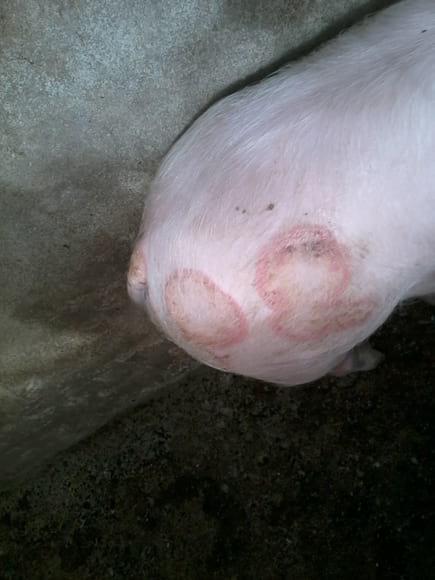Explore all the information on
Parasites on swine
Swine performance is influenced by internal parasites, most dramatically in the young, growing pig. Parasites reside in the stomach and intestinal tract of the pig, causing irritation, impaction, indigestion and lack of appetite. Parasites cause loss of nutrients from feed consumed by competing with the host, and by causing poor digestion, gut ulceration and even blood loss. Even small numbers of the large roundworm Ascaris suum can depress feed intake and daily gain and cause a depression in gain:feed ratio. Some worm parasites may be found in the lungs, where they interfere with respiration. This in turn may result in pneumonia.
Even though internal parasites are commonly associated with pasture and dry lot husbandry, some parasites such as Isospora (neonatal infection) may be present in total confinement. Ascarid infections frequently are found in finishing barns with concrete floors. The reason for continuing parasitism in these units is that transmission is by infective eggs and oocysts, which are difficult to keep out of any environment. Therefore, appropriate deworming schedules and sanitation are mandatory for parasite prevention programs.
There are only a few target parasites of concern, while several dewormers can be used effectively. The dewormers are usually broad spectrum in that most if not all of the worm parasites are removed, and they are safe and easily administered.
Introduction: Ascaris suum infections remain an important threat to the pig industry. A number of studies have been done in the last years regarding diagnosis, treatment and control. The aim of this study was to investigate the prevalence of A. suum in Belgium and to identify associations with farm management practices. Materials and Methods: Between January 2013 and December 2015, 162 commercial pig herds in Belgium were randomly selected...
Comments : 0
Recommendations: 0
Introduction: The field control of animal trypanosomosis has relied over the years on two broad strategies: using chemotherapeutic agents on infected animals, and vector control. At present chemotherapy and chemoprophylaxis are the only practical methods available for the control of animal trypanosomosis, but their effectiveness is being threatened by a number of factors, which include increasing parasite resistance, treatment failures and unacceptable...
Comments : 0
Recommendations: 0
Introduction: Gastrointestinal disease is one of the leading causes of clinical signs in growing and finishing pigs. We herein describe several diagnostic cases of finisher pig colitis wherein both novel and common pathogens were discovered. Materials and Methods: Necropsies of 5 pigs, 10-13 weeks of age, with diarrhea and weight loss, were performed at two swine farms, each housing > 15,000 growing pigs. Tissue samples including colon were submitted to the...
Comments : 0
Recommendations: 0
Introduction: Ascaris suum is a widespread parasitic nematode that causes infection in fattening pigs. The clinical symptoms are mostly vague and unspecific. Based on the high prevalence of infections with A. suum observed in fattening pigs, the questions arise whether exposure to A. suum mainly occurs in the fattening units or earlier on in farrowing and nursery units and whether serology could be used to detect exposure to A. suum in piglets. To...
Comments : 0
Recommendations: 0
Introduction: Due to consumption of Porcine Cysticercosis infected pork, a serious and life-threatening disease named Neuro- Cysticercosis has been reported in the 2-3% of weaker section of human population of rural and slum areas of Rajasthan state in India. 75% of hospitalized patients with neurocysticercosis were at productive age, and are frequently unable to work soon after the onset of symptoms associated with epilepsy. 90% of the pig’s population is raised by weaker...
Comments : 0
Recommendations: 0
Safglucan® – Mitigating the negative impact of Lawsonia intracellularis on pig performance and intestinal wellbeing. Phileo by Lesaffre has shown that feeding its yeast (1.3)(1.6) beta-glucan, Safglucan®, can help pigs cope better with the negative effect of enteric disorders caused by Lawsonia intracellularis. This is a new (patent pending) application for Safglucan® to help the pork industry achieve profitable production while also reducing antimicrobial...
Comments : 0
Recommendations: 0
Introduction: Loose housing systems for sows may have increased the occurrence and importance of Ascaris suum. Anthelmintic treatments can result in resistance development. Therefore identification of risk factors and development of alternative control strategies is relevant. The objective of this study was to identify risk factors associated with Ascaris suum egg counts in sows and gilts from intensive farms with loose housed sows. Materials and...
Comments : 0
Recommendations: 0
Introduction: Toxoplasma gondii continues being one of the main food safety hazards for pregnant women and immunocompromised patients. In this sense, the distribution of this protozoan within the organism and the role of the infective dose in tissue distribution are of highly interest to understand the risk associated to the parasite and to decipher the pathobiology of this infection. Materials and Methods: To carry out this study 11 Iberian pigs...
Comments : 0
Recommendations: 0
Introduction - vaccines against parasites In modern swine medicine, vaccination against various pathogens is an integral part of the health management. However, currently not a single vaccine against parasites of swine is commercially available. Compared to viral and bacterial pathogens, there is a general scarcity for anti-parasite vaccines; only two anti-nematode vaccines, one antitick-vaccine and a handful of antiprotozoal vaccines are available for domestic animals....
Comments : 1
Recommendations: 0
Introduction Ileitis (proliferative enteropathy of pigs), caused by the obligate intracellular parasite, the bacterium Lawsonia intracellularis, is the most common intestinal infection worldwide, affecting piglets in the rearing and fattening pigs. Arnold et al. (2018) detected a whole group of pathological changes in the small intestine. The disease occurs in four different forms, namely: regional ileitis, intestinal adenomatosis, hemorrhagic enteropathy, necrotic enteritis. It...
Comments : 0
Recommendations: 0
Ascaris suum is currently the only parasitic worm that is still highly prevalent in modern intensive pig production systems. However, due to the subclinical nature of the disease, ascariasis often remains undiagnosed, creating a lack of information regarding the worm-status of a farm, which ultimately makes it difficult for the farmers and the veterinarians to evaluate the applied deworming programs. In recent years, our group has developed and evaluated a serological test that can be used...
Comments : 0
Recommendations: 0
The favorable climate and low initial investment account for the popularity of raising pigs in dirt lots in the southeastern USA. The raising of swine on dirt, however, can pose several problems. One of these problems is that internal parasites (worms) are difficult to control, in particular in lots used over and over for swine. These parasites can cause swine to grow slowly and be unthrifty, and in severe cases can even kill swine. Fortunately, there are various chemical dewormers available...
Comments : 5
Recommendations: 0


Speculation over the Provisional Ruling on Anti-dumping Duties of Lysine by the EU Against China
Suggested link
Introduction Parasites have long been neglected but nowadays are becoming more recognized as important foodborne pathogens. Various factors contribute to their undervaluation such as complex lifecycles and transmission routes, prolonged incubation period and chronic disease manifestations. In addition, rapid and sensitive diagnostic assays are not always available and therefore parasite occurrences are often underreported, resulting in low disease...
Comments : 0
Recommendations: 0
Streptococcosis are diseases caused by different species of the genus Streptococcus and, in the case of swine, mainly due to Streptococcus suis . There are 35 recognised serotypes of S. suis, being the serotypes 2, 1/2, 7 and 9 the most frequently isolated in this...
Comments : 0
Recommendations: 1
The epidemiological cycle of Trypanosoma cruzi involves humans, the transmitting arthropod, and a large number of different naturally infected mammals. Mammals play an important role as reservoirs, specifically due to their close relationship with triatomines. The importance of the three mammalian cycles, wild, peridomestic, and domestic is well known; however, the present study concentrates on the peridomestic cycle because it links the other two, favouring that transmission of the...
Comments : 0
Recommendations: 0
Background - vaccines against parasites
In modern swine medicine, vaccination against various pathogens is an integral part of the health management. However, currently not a single vaccine against parasites of swine is commercially available. Compared to viral and bacterial pathogens, there is a general scarcity for antiparasite vaccines; only two anti-nematode vaccines, one anti-tick-vaccine and a handful of antiprotozoal vaccines are available for domestic...
Comments : 0
Recommendations: 0
Introduction The measure of the scientific quality and productivity of a particular researcher or research team has been traditionally a controversial issue. The topic is not trivial as it can be used by managers to evaluate professional promotions within a research institution, or by funding agencies and scientific panels to prioritize projects, grants and fellowships. The simplest way to tackle this challenge is...
Comments : 0
Recommendations: 0
Erysipelas is a severe infectious disease caused by the bacterium Erysipelothrix rhusiopathiae. The disease is well-known, but basic knowledge particularly on the infection in chickens, is lacking. A new project (EryPoP) will provide novel information that will enable scientifically based guidelines to...
Comments : 0
Recommendations: 0
Since parasites in commercial pig herds can cause economic loss to the producer in many ways including: decrease feed efficiency, increase time to market, and decrease carcass value. What would be the main procedures to be adopted to identify a worm problem? Look forward to hearing your experiences! ...
Comments : 6
Recommendations: 0







.jpg&w=3840&q=75)













